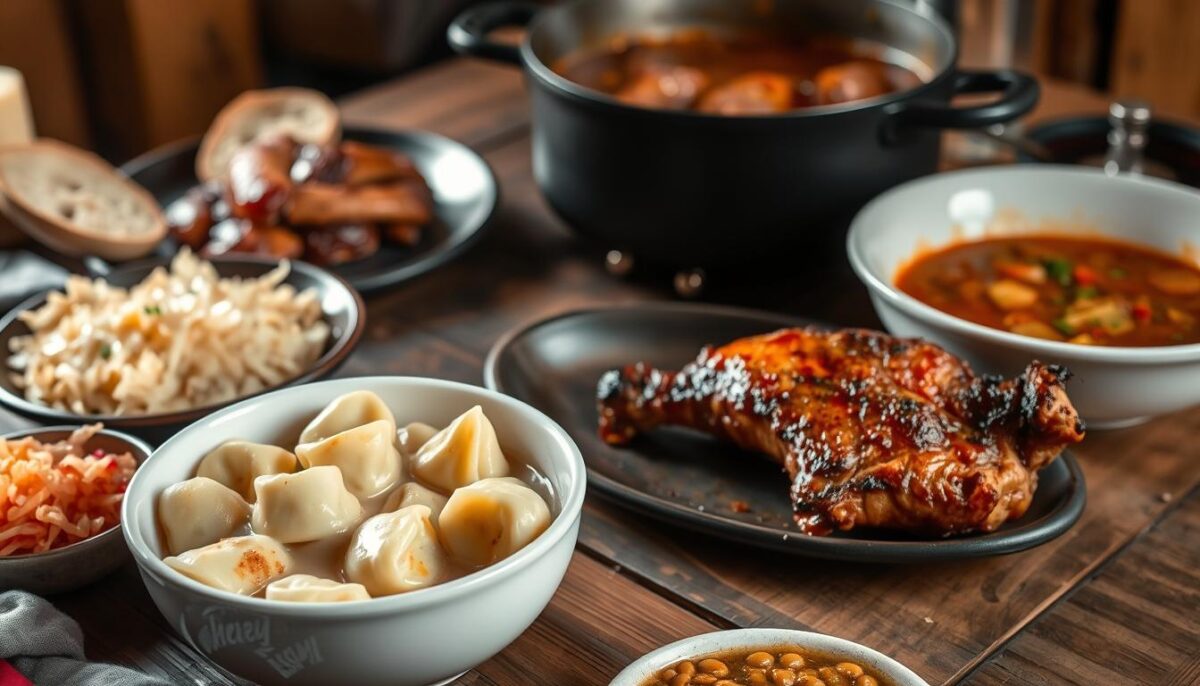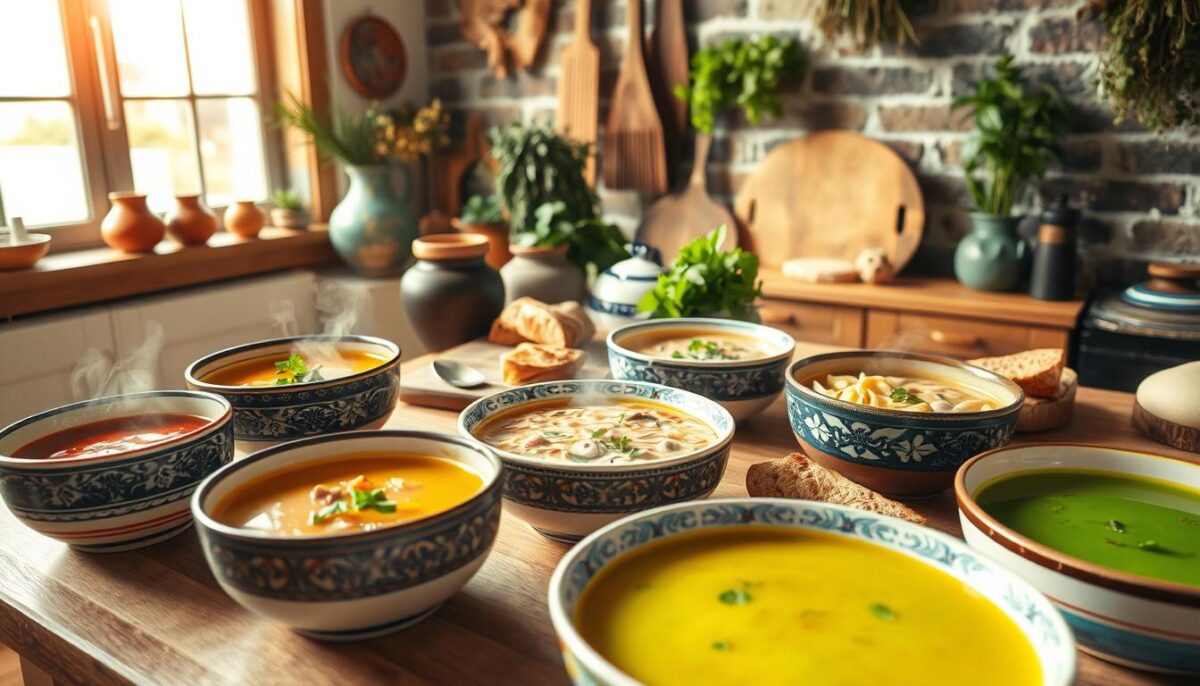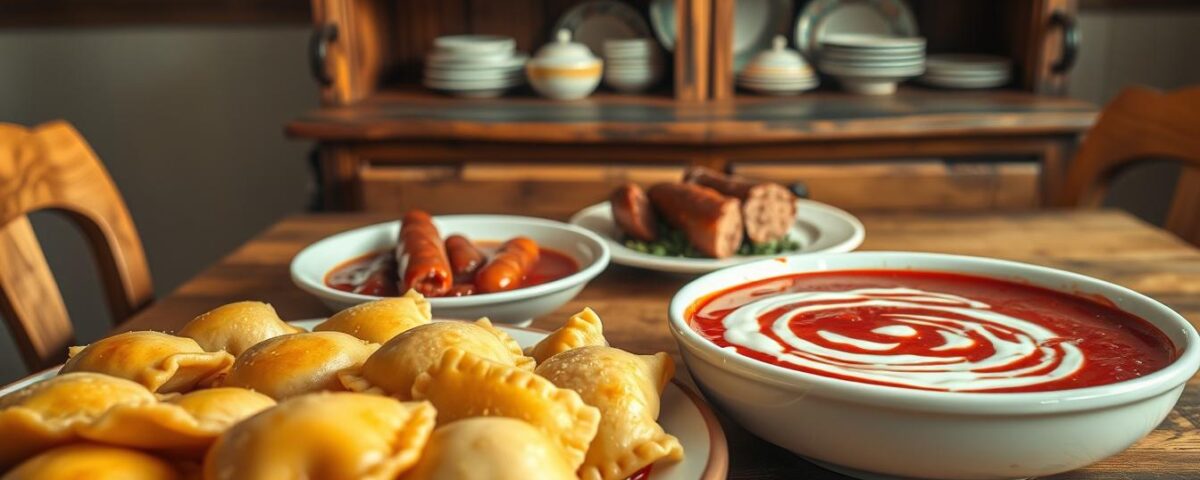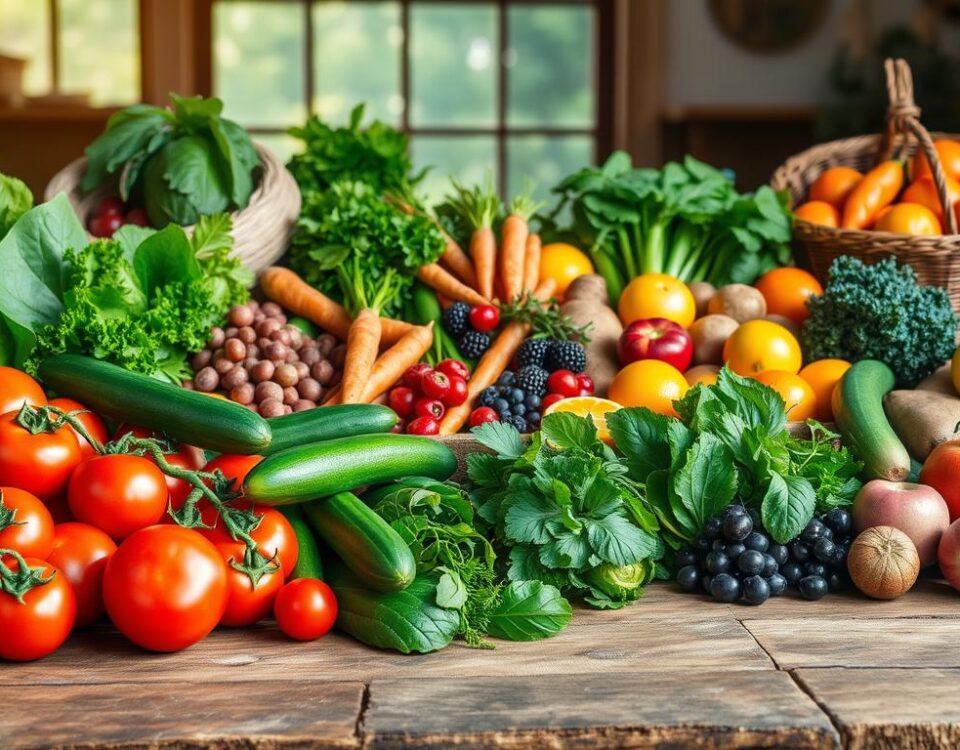
How to Host a Traditional British Roast Dinner
April 30, 2025
Why Everyone Is Talking About Filipino Food (Try These 3 Recipes!)
April 30, 2025When I was eight, my grandmother handed me a wooden spoon and said, “Food isn’t just eaten—it’s felt.” Standing in her tiny kitchen, surrounded by the scent of caramelized onions and smoked sausage, I didn’t understand what she meant. Years later, as I recreate her recipes, I realize she was teaching me how food weaves stories, history, and love into every bite.
Take żurek, for example—a tangy rye soup often served in a bread bowl. The first time I made it, I worried the sour flavor would clash with the smoky bacon. But when my friends tried it, their eyes widened. One whispered, “This tastes like a hug from someone you’ve missed.” That moment taught me how underrated these dishes are outside Poland.
This guide isn’t just a list. It’s a bridge between generations. I’ve spent months testing recipes, balancing tradition with modern kitchens. Some ingredients might seem unfamiliar, but trust me—they’re worth the effort. Ever tried adding dried mushrooms to a stew? They’re flavor time capsules.
Key Takeaways
- Discover seven lesser-known meals that redefine comfort food
- Learn techniques passed down through Polish families
- Find substitutions for hard-to-source ingredients
- Save time with prep shortcuts tested in home kitchens
- Understand the cultural stories behind each dish
Welcome to My Journey Through Polish Cuisine
My earliest food memory is biting into a warm pierogi while snowflakes melted on my mittens. That mix of buttery dough and savory filling taught me how classic Polish flavors could turn ordinary moments into magic. Today, I want to share that same wonder with you.
What makes Polish cuisine unforgettable? It’s the way smoked paprika whispers through a stew, or how fresh dill brightens a summer salad. Quality ingredients aren’t optional here—they’re the soul of every recipe. My aunt once told me, “A proper kapusta needs three things: patience, good cabbage, and louder laughter than your neighbors.”
Growing up, I watched family recipes adapt without losing their heart. We’d swap wild mushrooms for store-bought when needed, but never skimp on technique. This balance between tradition and practicality shapes how I approach modern takes on Polish cuisine.
You’ll notice historical fingerprints everywhere—from the use of buckwheat (a Tartar influence) to sweet-and-sour combinations borrowed from Jewish neighbors. These ingredients carry stories that make each bite richer.
Ready to explore further? Let’s uncover the building blocks of a traditional meal—starting with starters that’ll change how you think about classic Polish taste. Trust me, the surprises are just beginning.
A Glimpse into the Rich History of Polish Culinary Traditions
Centuries of change have simmered into every pot of Polish stew. I discovered this truth while digging through old family letters that described how meals evolved during sieges and famines. My great-aunt’s notes revealed a pattern: scarcity bred creativity. When invaders stripped pantries bare, cooks turned dandelions into salads and beet tops into savory fillings.
Historical events left fingerprints on Polish cuisine. During the 16th-century grain shortages, buckwheat became a staple. World War II forced families to stretch a single sausage across multiple meals. “We didn’t waste flavor,” a neighbor once told me, recounting how her mother boiled potato peels for broth. These stories show why preservation techniques like pickling cabbage or fermenting rye flour became lifelines.
| Period | Challenge | Culinary Innovation |
|---|---|---|
| Medieval Times | Harsh winters | Smoked meats, dried mushrooms |
| 18th Century | Partitions | Portable pierogi fillings |
| WWII Era | Food rationing | Vegetable-based “mock” dishes |
| Communist Rule | Ingredient shortages | Creative substitutions (e.g., margarine for butter) |
What fascinates me most isn’t just survival—it’s pride. Every jar of pickled cucumbers I make carries the stubborn joy of generations who refused to let hard times erase their traditions. This resilience transformed simple ingredients into comfort foods that still warm hearts today.
The connection between history and cuisine runs deeper than recipes. It’s in the way my hands automatically shape dough the way my grandmother did during air raids—a quiet rebellion against forgetting. That’s the real magic of Polish cuisine: it turns survival into art, one meal at a time.
Exploring Classic Starters and Soups
I still remember the first time I bit into a pierogi at a bustling Kraków market—steam escaping through the dough as I burned my tongue in excitement. These crescent-shaped wonders aren’t just food; they’re edible invitations to explore. Whether served as an appetizer or main dish, their versatility mirrors the resourcefulness I’ve come to love in traditional meals.
Pierogi and Zapiekanki: A Taste of Street Food
My cousin once joked, “Pierogi fillings are like snowflakes—no two families make them alike.” Classic versions feature mashed potato with farmer’s cheese, but I’ve tasted wild mushroom blends that made me rethink everything. The magic lies in the toppings: melted butter with crispy fried onions transforms each bite into something extraordinary.
Zapiekanki—open-faced baguettes piled with mushrooms and melted cheese—became my midnight craving during summer visits. Street vendors drizzle them with garlic sauce or sprinkle chives, proving simplicity often wins. “It’s not fancy,” a vendor once told me, “but it’s what we eat after the music stops.”
Red Borscht and Sour Rye Flour Soup: Comfort in a Bowl
Nothing prepared me for the ruby-red depth of my aunt’s borscht. Earthy beets mingle with tangy broth, while a dollop of sour cream adds velvet richness. Her secret? Simmering the soup for hours with a parsnip she fishes out before serving.
Then there’s żurek—the sour rye soup that sparked a family debate. My uncle insists smoked sausage belongs in every bowl, while my niece swears by hard-boiled eggs. Watching them argue over a steaming pot taught me these recipes aren’t just meals—they’re conversation starters dipped in tradition.
Diving into Hearty Main Dishes
The scent of caramelized onions and smoked bacon still lingers in my kitchen from last night’s feast. These flavors form the backbone of main dishes designed to warm you from the inside out—meals that turn weeknight dinners into celebrations.
Hunter’s Stew, Cabbage Rolls, and Schnitzel
My aunt’s hunter stew taught me patience. “Bigos isn’t cooked—it’s courted,” she’d say, stirring sauerkraut with three types of meat for hours. The tangy-sweet balance comes alive when wild mushrooms melt into the mix, creating a flavor deeper than any single ingredient.

Then there’s the humble magic of cabbage rolls. Blanketing spiced beef and rice in softened leaves feels like wrapping edible gifts. I once underestimated their simplicity until a friend confessed, “These taste like my childhood kitchen—safe and full of love.”
For crunch, nothing beats kotlet schabowy. Pounding pork cutlets thin ensures golden crispness without drying out the meat. My trick? A splash of milk in the breading for extra crunch that lasts through dinner.
Diverse Flavors from Potatoes to Pork
Potatoes play multiple roles here. Mashed with butter, they cushion rich stews. Shredded and pan-fried, they become crispy pancakes that outshine any side dish. Yet it’s the marriage of pork and potatoes that truly shines—think smoky sausage nestled in creamy potato salad.
What astonishes me most? These dishes transform basic elements into something extraordinary. A single bite of cabbage rolls simmered in tomato broth proves that heartiness needs no complexity—just care.
Discovering Unique Recipes Passed Down Through Generations
The first time I helped my aunt roll out pastry dough for a family recipe, flour dusted our fingertips like winter’s first snow. She handed me a faded notebook filled with measurements in pencil—some smudged by decades of use. “This is where we keep our secrets,” she whispered, pointing to a beetroot soup recipe that starts with sautéing garlic in butter until it sings.
Our traditional polish beetroot soup isn’t complete without a swirl of mushroom sauce made from foraged fungi. My grandfather taught me to simmer it with a pinch of marjoram, creating an earthy depth that store-bought versions lack. Recipes like this aren’t just instructions—they’re edible heirlooms.
Sweet treasures hide in that notebook too. A poppy seed cake, layered with honey-soaked nuts, requires a texture so light it practically floats off the plate. My cousin once joked, “If the batter doesn’t make your arm ache from stirring, you’re not doing it right.”
Over generations, measurements shifted from “a handful” to cups—but the soul remains. We’ve swapped lard for butter in some recipes, yet kept the crackle of caramelized sugar on cake edges intact. These tweaks prove traditions can adapt without losing their heartbeat.
Try recreating one of your family’s traditional polish staples this week. Whether it’s a soup or dessert, let each step connect you to those who cooked before you. After all, every stirred pot carries whispers from kitchens past.
Your Polish dishes cooking guide: Embracing Traditional Techniques
Mastering traditional methods feels like learning a secret language—one where folded dough and simmered broths whisper family histories. My neighbor once showed me how to test cabbage leaves for flexibility by holding them to light. “They should glow like stained glass,” she said, demonstrating the perfect wrap for rolls.
Slow cooking transforms humble ingredients. I learned this while watching my uncle layer sauerkraut and tomato sauce in a clay pot—each stratum building flavor over six hours. Recipes demand patience, but the reward is tenderness that melts on your tongue.
| Technique | Traditional Method | Modern Adaptation | Key Benefit |
|---|---|---|---|
| Dough Prep | Hand-kneaded 20 minutes | Stand mixer with dough hook | Consistent texture |
| Slow Simmering | Wood-fired stove | Slow cooker on low | Depth of flavor |
| Cabbage Handling | Salt-massaged leaves | Quick-blanch in boiling water | Flexible wrappers |
| Sauce Techniques | Tomato reduction over coals | Oven-roasted concentrate | Rich umami base |
| Preservation | Cellar fermentation | Refrigerator pickling | Tangy crunch |
Fresh cabbage makes all the difference. I once substituted pre-shredded coleslaw mix in a recipe—the result lacked the earthy sweetness that defines authentic Polish dishes. Now I core heads whole, savoring the crisp snap as leaves separate.
Adapting traditions doesn’t mean abandoning them. My grandmother’s pierogi dough works equally well with gluten-free flour. The trick? Adjust hydration slowly until it feels “like a baby’s earlobe”—her exact words from 1973.
Try these methods next time you explore Polish dishes. Whether perfecting rolls or balancing sauces, each technique connects you to kitchens where meals were miracles wrought from simple tools and simpler ingredients.
Delightful Salads and Refreshing Sides
I once watched my cousin defuse a heated dinner debate by sliding a bowl of chilled cucumber salad across the table. The crunch of fresh slices cut through the smoky richness of roasted pork, reminding everyone why these deceptively simple sides matter. They’re not afterthoughts—they’re essential counterpoints.
Mizeria and Creamy Cucumber Salad
Mizeria—meaning “misery” in Polish—is anything but dreary. Thinly sliced cucumbers swim in a tangy bath of sour cream and dill, with a whisper of lemon. My trick? Salt the slices first to draw out moisture. “You want them crisp, not soggy,” my aunt would say, patting them dry with a linen cloth.
This salad shines alongside pierogi or mashed potatoes. The cool creaminess balances earthy fillings like mushroom or sauerkraut. For extra zing, I sometimes add radishes cut paper-thin.
Polish Cold Vegetable Salad and Pickled Delicacies
Summer picnics introduced me to cold vegetable salads bursting with color. Boiled carrots, peas, and pickles mingle in a mayo-dill dressing. My neighbor’s version includes diced apples for sweetness—a twist I’ve stolen proudly.
Pickled veggies are pantry heroes here. A forkful of fermented cabbage cuts through rich stews better than any bread. Try layering them beneath mashed potatoes in a casserole—the tang lifts every bite.
Pairing tip: Match sharper salads with milder mains. A vinegary beet salad transforms plain roasted chicken into something memorable. Balance isn’t just taste—it’s alchemy.
Savoring Comforting Soups for Every Season
I discovered the magic of chilled beet soup on a sweltering summer day. My neighbor slid a pink bowl across her picnic table, condensation dripping down the sides. “Winter warms bones,” she said, “but summer cools hearts.” That first sip of chłodnik—creamy, tangy, flecked with dill—taught me soups here defy seasons.

These broths adapt like nature. Hearty żurek with smoky sausage fuels snowy days, while chilled versions refresh during heatwaves. The key lies in balancing earthy potatoes with sharp onions—a dance between comfort and zest.
| Soup | Base | Star Ingredient | Perfect Pairing |
|---|---|---|---|
| Żurek | Fermented rye | Boiled eggs | Crusty bread |
| Chłodnik | Buttermilk | Fresh beets | Dill potatoes |
| Kartoflanka | Meat broth | Potato slices | Pickled veggies |
Many double as elegant appetizers. At a Warsaw dinner party, I watched a shot glass of wild mushroom consommé wow guests before the main recipe. The host grinned: “First impressions matter, even in bowls.”
For best results, roast potatoes before adding to broth—it deepens their sweetness. Always sweat onions slowly until golden. And don’t fear serving cold soups in fancy bowls; presentation elevates humble ingredients.
Last fall, I perfected a potato pancake garnish for my pumpkin soup. Crispy shreds added texture contrast that made leftovers disappear. That’s the beauty here—every season invites new twists on timeless warmth.
Celebrating Festive Flavors and Holiday Traditions
The scent of melted butter and orange zest still transports me to my grandmother’s kitchen on Christmas Eve. Holiday baking here isn’t just about treats—it’s a chorus of laughter, clattering pans, and whispered secrets between generations. Special days like Fat Thursday (when we devour pączki by the dozen) or Wigilia dinners weave magic into every bite.
Pączki and Poppy Seed Cake for Special Occasions
Making pączki taught me the joy of imperfection. These jam-filled donuts demand patience—too much yeast, and they’ll burst like overexcited balloons. My cousin once joked, “The best ones have a little ‘character’ splatter on the stove.” Dusted with powdered sugar, they’re edible confetti for life’s sweetest moments.
Poppy seed cake carries deeper meaning. Each slice of makowiec symbolizes prosperity, with crushed seeds representing countless blessings. My aunt’s recipe requires soaking the seeds overnight in milk—“to soften their edges, just like time softens memories.”
During holidays, especially Christmas, these recipes become time machines. I still use my great-grandmother’s handwritten notes, stained with vanilla extract and nostalgia. Her looping cursive reminds me: “Measure love by the pinch, not the cup.”
Want to create your own traditions? Start with poppy seed cake this year. Share it with neighbors or savor it quietly with coffee. After all, holidays taste brightest when seasoned with connection.
My Personal Experience with Polish Home Cooking
My first attempt at making pierogi ended with dough stuck to the ceiling—and my mother’s laughter echoing through the house. That messy afternoon taught me more about the heart of meals than any perfect result ever could. “Recipes are maps,” she said, wiping flour from her cheek, “but your hands decide the journey.”

Through countless tests, I’ve learned that traditional recipes thrive on balance. My grandmother’s beet soup requires tasting seven times as it simmers—adding honey when the vinegar bites too sharp, adjusting dill until earthiness shines. This dance between measurement and instinct transforms ingredients into memories.
| Traditional Method | Modern Test | Key Lesson |
|---|---|---|
| Taste-as-you-go | pH strips for acidity | Trust senses first |
| Wooden spoon texture checks | Digital thermometers | Touch reveals truth |
| Three-generation taste panels | Blind peer reviews | Balance preferences |
Time spent in our kitchen taught me flavors speak louder than words. I once spent hours perfecting a recipe, only to have my uncle remark, “Close, but missing the smudge of burnt onion from your aunt’s pan.” Now I intentionally char one piece—a flavor wink to our history.
These meals shaped my understanding of connection. Every folded dumpling carries stories of time-tested love. I invite you to try my family’s cabbage roll method—and add your own fingerprint. After all, the best taste memories begin with your hands in the dough.
Innovative Twists on Time-Honored Polish Dishes
Last winter, I discovered that adding roasted parsnips to my grandmother’s cabbage roll recipe made my skeptical uncle ask for seconds. This sparked my journey of reimagining classics—keeping their soul while adding modern flair. The key? Respect tradition, but let creativity simmer.
Through tests, I found surprising swaps that work. Try wrapping cabbage rolls in collard greens for extra crunch. Or mix grated apples into potato pancakes—their sweetness balances smoky sausage perfectly. These tweaks keep dishes exciting without erasing their heritage.
| Traditional Dish | Modern Twist | Flavor Boost |
|---|---|---|
| Cabbage Rolls | Kimchi-spiced filling | Tangy umami kick |
| Żurek Soup | Quinoa instead of rye | Nutty gluten-free base |
| Potato Pancakes | Sweet potato blend | Vitamin-rich crispness |
Time-saving hacks help too. I now bake cabbage rolls in muffin tins—they cook 25% faster. For quick pickling, use rice vinegar and a pressure cooker. My aunt’s 4-hour stew? It’s now Instapot-ready in 90 minutes.
Don’t fear recipe experiments. Swap half the cabbage in soups with kale for color. Turn leftover rolls into air-fryer “croutons” for salads. Every kitchen deserves its own edible story—what will yours taste like?
Tips and Tricks for Authentic Polish Cooking
My quest for authentic flavors began in a cramped market stall, where a vendor handed me a wrinkled beet with soil still clinging to its roots. “This is how they grow—no shortcuts,” he said. That moment reshaped how I source ingredients for every recipe.

From Farm to Fork: The Ingredient Journey
Every part of preparation matters. Seek rye flour stone-ground in small batches—it adds earthy depth to soups that industrial mills can’t match. For spices, whole caraway seeds toasted fresh beat pre-ground versions every time.
| Ingredient | Traditional Source | Modern Alternative |
|---|---|---|
| Farmers Cheese | Local dairy cooperatives | Whole-milk ricotta + lemon zest |
| Wild Mushrooms | Forest foraging | Rehydrated dried porcini |
| Sour Rye Starter | Multi-generational bakeries | 72-hour DIY fermentation |
My weekly market ritual includes three checks: smell (fresh dill should sting your nose), texture (cabbage leaves must crackle when bent), and color (beets bleed ruby-red on paper towels). These tests ensure ingredients meet my grandmother’s standards.
While I love my slow cooker, some recipes demand old-school methods. Simmering bone broth overnight develops flavors no pressure cooker can replicate. Yet I’ll use frozen dough when time’s short—authenticity lives in the dish, not just the process.
Remember: each ingredient carries history. Smoked plums in stews? They echo preservation methods from pre-refrigeration eras. Honor those stories, and every recipe becomes a tribute.
Essential Tools for Crafting Perfect Polish Meals
I learned the value of proper tools the hard way—using a steak knife to core cabbage left my counter looking like a crime scene. Authentic flavors demand more than good ingredients; they require utensils that honor tradition while tackling modern kitchens.
| Tool | Traditional Use | Modern Benefit |
|---|---|---|
| Deep enamel pot | Slow-stewing soups | Even heat for creamy polish potato mash |
| Wooden dough scraper | Pierogi shaping | Non-stick handling for delicate fillings |
| Carbon steel knives | Precision cabbage slicing | Maintains vegetable texture integrity |
My grandmother’s cast-iron potato masher taught me why old-school tools win. Its weight crushes spuds smoothly without gumminess—something plastic gadgets often miss. Yet I’ve embraced silicone baking mats for easier cleanup when roasting beetroots.
For dough-based meals, a linden wood rolling pin makes all the difference. Its porous surface absorbs excess flour, preventing tough crusts. Pair it with a hand-crank noodle cutter for perfect kluski thickness every time.
Invest in these essentials, and watch your polish potato pancakes crisp evenly. Remember: Great tools don’t just make cooking easier—they carry centuries of kitchen wisdom in their curves.
Pairing Polish Meals with the Ideal Sides and Sauces
The first time I paired a tangy mushroom sauce with crispy breaded pork, my kitchen timer became a metronome for flavor symphonies. Finding harmony between mains and accompaniments isn’t just art—it’s edible science. A well-chosen side or drizzle can elevate humble ingredients into memorable feasts.
From Earthy to Bright: Sauce Transformations
Rich tomato sauce works wonders on milder meats. Simmer it with smoked paprika to cut through creamy potato dumplings. For earthy depth, sauté wild mushrooms with thyme before blending into velvety mushroom sauce—it turns roasted veggies into luxury.
Crunchy breaded pork demands contrast. I serve it with chilled apple-fennel slaw for freshness. The trick? Toss shredded cabbage in lemon-dill dressing right before plating. This keeps textures crisp while balancing golden-brown crusts.
Three pairing principles I live by:
- Match intensity: Bold sauces with robust mains, delicate ones with lighter proteins
- Play with temperature: Warm tomato sauce over cool beet salads creates surprise
- Add crunch: Toasted buckwheat sprinkled on mushroom sauce adds dimension
Last week, a friend raved about my schnitzel combo: crispy breaded pork with tangy cucumber side salad. “The pickles wake up the whole plate!” she said. That’s the power of thoughtful pairings—they make flavors sing in chorus, not competition.
Adapting Polish Recipes for Modern American Kitchens
I once burned a batch of potato pancakes so badly they stuck to the pan like concrete. That disaster taught me how to bridge old-world recipes with New York apartment realities. Now I use cast iron skillets instead of my grandmother’s copper pans—same golden crispness, half the scrubbing.
Key swaps keep flavors authentic. For potato pancakes, russet potatoes work better than waxy varieties. Grate them fresh—never frozen—and squeeze moisture through cheesecloth. My trick? Add a spoon of cornstarch to mimic traditional binders when eggs are scarce.
Busy schedules demand clever shortcuts. Slow-simmered bread soups become Instant Pot miracles in 45 minutes. Swap hard-to-find rye starter with sourdough discard for tangy żurek. “If it tastes like home, it is home,” my cousin declared after trying my pressure-cooked version.
- Use Greek yogurt instead of twaróg cheese in fillings
- Roast jarred beets with caraway for quick cucumber salad toppings
- Bake pancakes on parchment paper for even browning
My biggest lesson? Tradition thrives through adaptation. When I replaced lard with avocado oil in a century-old recipe, my aunt mistook it for her own. Some purists may frown, but flavor never lies. After all, innovation honors heritage when done with care.
A Look Back at Classic Flavors from the Past
Winter nights meant beef-stuffed cabbage rolls bubbling in our oven, their aroma weaving through drafty halls. That rich, earthy scent carried whispers of my great-grandmother’s kitchen—where every dish told stories through thyme and caraway seeds.
Traditional recipes endure through clever adaptation. My aunt’s beef goulash still simmers for hours like in 1950s Warsaw, but now features grass-fed meat. “Good food bends without breaking,” she says, swapping lard for olive oil while keeping paprika’s smoky soul intact.
Three elements define these timeless dishes:
- Hearty foundations (think potatoes roasted in duck fat)
- Bold contrasts (sour cream cutting through rich stews)
- Memorable textures (crispy beef crusts against soft dumplings)
At harvest festivals, I watched neighbors pass recipe cards like love letters. Their stained edges held secrets: vinegar ratios for perfect borscht, the exact moment to flip potato pancakes. These ingredients became time machines—each bite transporting us to weddings, holidays, and rainy Tuesday dinners.
Modern kitchens can honor these flavors without museum-like precision. Try adding espresso powder to beef marinades for depth, or roast root vegetables with honey-mustard glaze. The goal isn’t replication, but celebration—keeping the past alive through every reinvented dish.
What classic food memory will you recreate this week? Whether tweaking family recipes or discovering new ones, remember: great flavors outlive trends when seasoned with care.
Conclusion
This journey through simmering pots and family kitchens taught me how food becomes legacy. From tangy soup bases to golden potato pancakes, each bite carries generations of resourcefulness and joy.
Every recipe here connects past and present. Hearty cabbage rolls share stories of survival, while modern twists on classics prove traditions evolve without losing soul. Even simple touches—a drizzle of garlic sauce or perfectly folded dough—turn meals into celebrations.
I hope these flavors spark your curiosity. Try caramelizing onions for stews, or shape pierogi with your own twist. Authenticity isn’t about perfection—it’s about honoring the hands that shaped these dishes long before ours.
As my grandmother would say while adjusting her apron: “Good food needs two things—patience and a loud laugh.” May your kitchen echo with both as you explore these timeless tastes.
FAQ
What’s the best meat substitute for cabbage rolls if I don’t eat pork?
I’ve found ground turkey or beef works well, but mushrooms add a hearty vegetarian twist. Just season generously to match the savory flavor of traditional recipes.
Can I make potato pancakes ahead of time for a crowd?
Absolutely! Fry them until golden, let them cool, and reheat in the oven. Serve with sour cream or applesauce—they stay crispy and delicious.
How do I prevent my pierogi dough from tearing during cooking?
Keep the dough rested and pliable. Roll it thin but not transparent, and avoid overstuffing. A quick boil followed by pan-frying gives the perfect texture.
What sauce pairs best with breaded pork schnitzel?
I love a creamy mushroom sauce or zesty lemon-butter drizzle. For a tangy kick, try a quick dill-infused sour cream dip on the side.
Is hunter’s stew (bigos) freezer-friendly?
Yes! The flavors deepen over time. Freeze portions in airtight containers and reheat slowly—it’s ideal for meal prep or cozy winter nights.
Why is poppy seed cake so popular during Polish holidays?
Poppy seeds symbolize prosperity and abundance. The rich, nutty flavor and dense texture make it a festive favorite, especially around Christmas and Easter.
Can I use store-bought broth for sour rye flour soup (żurek)?
Homemade broth shines, but a quality store-bought version works. Just balance it with the fermented rye base and smoked sausage for that authentic tang.
What’s the secret to creamy cucumber salad (mizeria)?
Slice cucumbers paper-thin, salt them to draw out moisture, and pat dry. Mix with fresh dill, a splash of lemon, and full-fat sour cream for maximum creaminess.
Are mashed potatoes the only side for cabbage rolls?
Not at all! Try buttered barley or roasted root veggies. I’ve even served them over buckwheat for a nutty contrast to the tomato-based sauce.
How do I add a modern twist to classic pierogi fillings?
Experiment with sweet potato and goat cheese or spinach-artichoke blends. For dessert, dark chocolate and orange zest make a decadent surprise inside.



